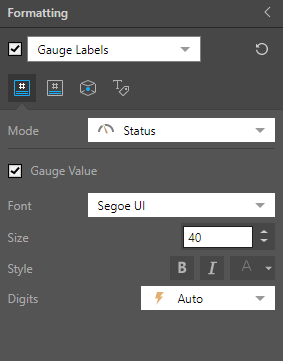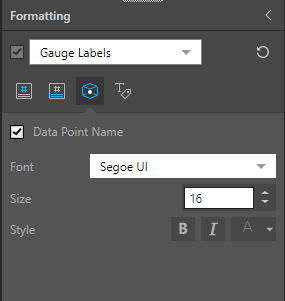When working with gauges, you can show labels so that users can easily understand which measures are being compared, and what the value of each measure is in each gauge.
The Gauge Labels dialog is used to customize the following gauge components:
- Primary Label: The primary label is the numeric value (red highlight below).
- KPI Name: This is the label directly underneath the value (orange arrow below). If the gauge was built on the fly in the Discover, the default name will be the labels of the measure(s) in the Values drop zone, the measure in the Status drop zone, and the member element(s) from the given hierarchy or hierarchies. If the gauge is based on a custom KPI built in Formulate, the KPI Name will be the name that the KPI was saved as.
- Data Point Name: This label (purple arrow below) displays the member elements represented by the gauge (the member element(s) from the hierarchies in the Trellis drop zones).
- Secondary Label: This label displays the values that are not set as the primary label (blue arrow below).

Access Gauge Labels
Component Ribbon
The Gauge Labels button (green arrow below) and the Gauge Value button (red arrow) are shown on the ribbon when working with gauges:

- Click Gauge Labels (green) to Show or Hide the Gauge labels.
- Click Gauge Value and one of Status, Target, or Value to change the text used as the value on the gauge. For more information, see Gauge Value.
Additionally, you can click Auto Fit Labels to Enable or Disable the Auto Fit functionality that makes your label text resize automatically to fit the available space. Note that, where the Auto Fit Labels option is enabled, the sizes of your labels (entered in this panel) still affect the size of the text in the gauge; instead of them setting the exact size of the text, they allow the Auto Fit function to find a relative size for the different parts of the label. For more information, see Auto Fit Labels.
Formatting Panel
Open the Formatting panel and set the drop-down selection to Gauge Labels:
Primary
From the Primary tab, set the gauge values and adjust the gauge's style.
- Click here to learn more about gauge values.

- Mode: Select which gauge value to show in the middle of the gauge - status, target, or value.
- Gauge Value: Show or hide the gauge value.
- Font: Change the font type for the KPI value.
- Size: Change the size of the KPI value.
- Style: Change the style (bold, italics, or color) of the KPI value.
- Digits: Change the units of the KPI value.
KPI Name
From the KPI Name tab, show or hide the KPI name and set styling for it.

- KPI Name: Show or hide the KPI name.
- Font: Change the font type for the KPI name.
- Size: Change the size of the KPI name.
- Style: Change the style (bold, italics, or color) of the KPI name.
Data Point
From the Data Point tab, show or hide the Data Point Name and set styling for it.

- Data Point Name: Show or hide the data point name.
- Font: Change the font type for the data point name.
- Size: Change the size of the data point name.
- Style: Change the style (bold, italics, or color) of the data point name.
Secondary
From the Secondary tab, show or hide the secondary values and set styling for them.

- Secondary: Show or hide the KPI secondary values (the values that are not set as the KPI value).
- Font: Change the font type for the secondary values.
- Size: Change the size of the secondary values.
- Style: Change the style (bold, italics, or color) of the secondary values.
- Background Color: Use the color picker to change the color of the report background, without affecting the gauges.